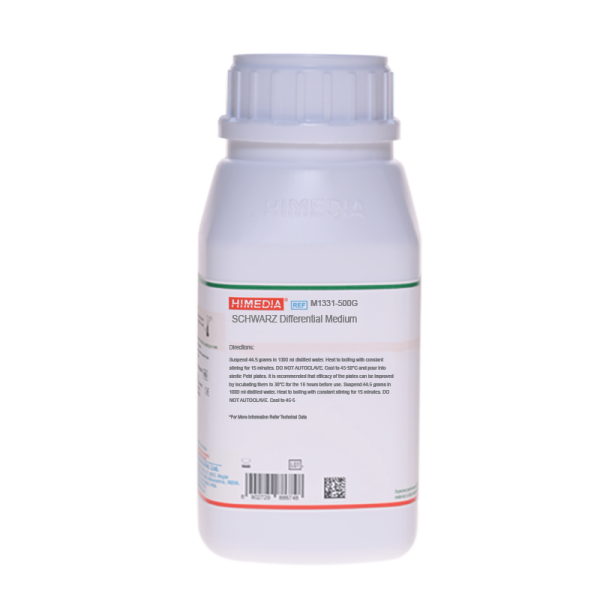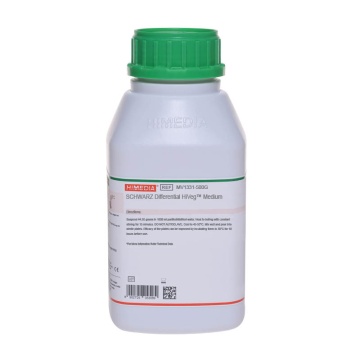 Your enquiry has been submitted
Your enquiry has been submitted
SCHWARZ Differential Medium
Intended Use:
Used in the brewing industry for the differentiation of brewing yeasts from wild yeasts.
Composition**
| Ingredients | Gms / Litre |
|---|---|
| Peptone | 5.000 |
| Yeast extract | 3.000 |
| Malt extract | 3.000 |
| Dextrose (Glucose) | 10.000 |
| Basic fuchsin | 0.470 |
| Sodium sulphite | 2.920 |
| Dextrin | 0.110 |
| Agar | 20.000 |
Final pH (at 25°C): 6.9±0.2
**Formula adjusted, standardized to suit performance parameters
Directions
Suspend 44.50 grams in 1000 ml purified / distilled water. Heat to boiling with constant stirring for 15 minutes. DO NOT AUTOCLAVE. Cool to 45-50°C and pour into sterile plates. Efficacy of the plates can be improved by incubating them to 30°C for 18 hours before use.
Caution: Basic fuchsin is a potential carcinogen and care should be taken to avoid inhalation of the powdered dye and contamination of the skin.
Principle And Interpretation
Schwarz Differential Medium is recommended for use in the brewing industry for the differentiation of brewing yeasts from wild yeasts (1,4). Malt extract, peptone and yeast extract provide necessary nutrients to support the growth of yeasts. Dextrose is the suitable carbohydrate for the growth of yeasts. Sodium sulphite and basic fuchsin inhibit the gram-positive microorganisms.
The prepared plates darken during incubation. Wild yeasts form pink colonies which may be smooth, mucoid or wrinkled. Brewing yeasts forms a thin haze of micro colonies which blend with the colour of the medium.
Type of specimen
Brewery sample
Specimen Collection and Handling:
For brewery samples follow appropriate techniques for handling specimens as per established guidelines (2,3).
After use, contaminated materials must be sterilized by autoclaving before discarding.
Warning and Precautions :
Read the label before opening the container. Wear protective gloves/protective clothing/eye protection/ face protection. Follow good microbiological lab practices while handling specimens and culture. Standard precautions as per established guidelines should be followed while handling specimens. Safety guidelines may be referred in individual safety data sheets.
Limitations :
- Due to nutritional variation, certain strains may show less growth.
Performance and Evaluation
Performance of the medium is expected when used as per the direction on the label within the expiry period when stored at recommended temperature.
Quality Control
Appearance: Pinkish purple to Purple coloured homogeneous free flowing powder
Gelling: Firm, comparable with 2.0% agar gel.
Colour and Clarity of prepared medium: Light pink coloured clear to slightly opalescent gel forms in Petri plates
Reaction: Reaction of 4.45% aqueous solution at 25°C. pH: 6.9±0.2
pH: 6.70-7.10
Cultural Response
Cultural response observed at 30°C for upto 4 days. (colour of plates darkens during incubation).
| Organism | Inoculum (CFU) | Growth | Recovery | Colour of Colony |
|---|---|---|---|---|
| Candida albicans ATCC 10231 (00054*) | 50-100 | luxuriant | >=50% | white to light pink raised colonies |
| Candida kruisei ATCC 24408 | 50-100 | luxuriant | >=50% | pink, rough, flat colonies |
| Saccharomyces cerevisiae ATCC 9763 (00058*) | 50-100 | luxuriant | >=50% | pink colonies |
Key: *Corresponding WDCM numbers.
Storage and Shelf Life
Store between 10-30°C in a tightly closed container and the prepared medium at 20-30°C. Use before expiry date on the label. On opening, product should be properly stored dry, after tightly capping the bottle in order to prevent lump formation due to the hygroscopic nature of the product. Improper storage of the product may lead to lump formation. Store in dry ventilated area protected from extremes of temperature and sources of ignition. Seal the container tightly after use. Product performance is best if used within stated expiry period.
Disposal
User must ensure safe disposal by autoclaving and/or incineration of used or unusable preparations of this product. Follow established laboratory procedures in disposing of infectious materials and material that comes into contact with sample must be decontaminated and disposed of in accordance with current laboratory techniques (2,3).
Reference
- A. van der Aa Kühle, L. Jespersen, Detection and identification of wild yeasts in lager breweries, Int. J. of Food Microbiol., Vol. 43, 3, p 205-213 (1998).
- Isenberg, H.D. Clinical Microbiology Procedures Handbook 2nd Edition.
- Jorgensen, J.H., Pfaller, M.A., Carroll, K.C., Funke, G., Landry, M.L., Richter, S.S and Warnock., D.W. (2015) Manual of Clinical Microbiology, 11th Edition. Vol. 1.
- L. Jespersen, M. Jakobsen, Specific spoilage organisms in breweries and laboratory media for their detection, Int. J. of Food Microbiol., Vol. 33, 1, p 139-155 (1996).
- T. Deák, L.R. Beuchat, Handbook of food spoilage yeasts, 2nd Edition (2007)
| Product Name | SCHWARZ Differential Medium |
|---|---|
| SKU | M1331 |
| Product Type | Regular |
| Physical Form | Powder |
| Origin | Animal |
| Packaging type | HDPE |
| References | 1.A. van der Aa Kühle, L. Jespersen, Detection and identification of wild yeasts in lager breweries, Int. J. of Food Microbiol.,Vol. 43, 3, p 205-213 (1998). |
| Customized Product Available | No |









